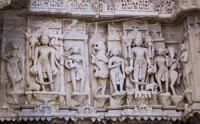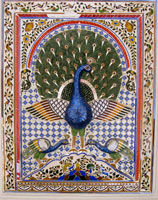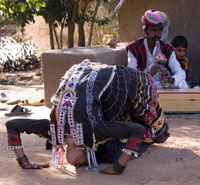Around Udaipur
I spent the day wandering around Udaipur, in the morning I visited the Jagdish Temple and the Bagore-ki-Haveli. I don’t have much interest in religious temples apart from an architectural standpoint, but the Jagdish Temple was an incredibly impressive design, covered in very delicate and ornate stone carvings depicting everything from scenes of Vishnu to elephants butting heads.
 I walked around the main building for a while watching the various supplications going on, one in particular caught my eye, a father and his young son, two maybe three years old, came to pray at the sun god temple on the southeast side of the complex and the boy seemed to instinctively know that something important was going on and as he approached he put his hands together as you would to say namaste, but his father had to show him how to bow and at first he did not, the father had to place his hand on the boy’s head and show him what to do which made me feel slightly better, perhaps genuflection is not instinctive with in us, but taught by culture. I sat down on a bench and tried to make sense of the bewildering tangle of carvings on the sides of the main temple. I started thinking about the Taj Mahal, which, for those like myself that did not know this, is actually a mausoleum. I don’t know what all the so-called seven wonders of the world are off the top of my head, but I do know that the Taj Mahal is one and the pyramids in Egypt are another which means two out of seven, possibly more, of man’s greatest structures are essentially graves. Not temples or churches or monuments, but tombs.
I walked around the main building for a while watching the various supplications going on, one in particular caught my eye, a father and his young son, two maybe three years old, came to pray at the sun god temple on the southeast side of the complex and the boy seemed to instinctively know that something important was going on and as he approached he put his hands together as you would to say namaste, but his father had to show him how to bow and at first he did not, the father had to place his hand on the boy’s head and show him what to do which made me feel slightly better, perhaps genuflection is not instinctive with in us, but taught by culture. I sat down on a bench and tried to make sense of the bewildering tangle of carvings on the sides of the main temple. I started thinking about the Taj Mahal, which, for those like myself that did not know this, is actually a mausoleum. I don’t know what all the so-called seven wonders of the world are off the top of my head, but I do know that the Taj Mahal is one and the pyramids in Egypt are another which means two out of seven, possibly more, of man’s greatest structures are essentially graves. Not temples or churches or monuments, but tombs.
After the temple visit I wandered down toward the lakeshore and bought a ticket to the Bagore-ki-Haveli. Another word I did not know, but can now offer the dictionary definition: haveli, traditional, often ornately-decorated, residences, which of course means nothing to me or you, except to say that perhaps this is how the upper middle class and upper class, but not quite royalty, seems to have lived. There are havelis all over India, but they seem to mainly be a focus in Rajasthan and Gujarat, and it’s here that the most effort has been made to restore some of these often decrepit buildings to their once and former glory. The Bagore-ki-Haveli is one of the high points of these restoration projects. It took five years to restore and capturing the lifestyles of the rich circa 1780.
Comprising a total of 138 rooms it took me sometime to negotiate the entire museum, which in a way resembles the nicest most labyrinthine dorm you’ve ever imagined. There were elegant and gracefully decorated rooms that in many ways reminded me of Japanese paintings in and their minimalist, almost spartan aesthetic. There were also rooms for the more everyday life, kitchen equipment, including the biggest cooking bowl—I would say wok, but I know it’s not a wok, still it looks like a wok— I’ve ever seen which was easily six feet in diameter, and then there were game rooms with gorgeous chess sets and some games I didn’t recognize, they even restored the bathroom, which was a stunning example of the frozen sense of time that exists in India, since it looks exactly the same as the average India bathroom of today. There were also more of the same inlaid glass peacocks that I saw at the City Palace two days ago.
 Throughout my time in the Haveli I couldn’t quite escape the feeling of false history, of idealizing a culture whose great wealth and power existed on the back of people who are not remembered, whose homes are not on display and whose lives are barely recorded. I guess that to some extent the architecture and daily life of those people vanishes when they do, which is a shame. Obviously it isn’t the workers that get to write the story of the building, save with their anonymous hands that laid the stones and marble in place and perhaps the perfection and beauty of the stone is in the end a more lasting monument than restored trinkets and board games. The rich may have lived and played in the Haveli, but the stone workers who built it and the craftsmen and women who carved the intricate chess pieces and pounded out the giant metal cookware are what made the Haveli a place that anyone wanted to live in the first place.
Throughout my time in the Haveli I couldn’t quite escape the feeling of false history, of idealizing a culture whose great wealth and power existed on the back of people who are not remembered, whose homes are not on display and whose lives are barely recorded. I guess that to some extent the architecture and daily life of those people vanishes when they do, which is a shame. Obviously it isn’t the workers that get to write the story of the building, save with their anonymous hands that laid the stones and marble in place and perhaps the perfection and beauty of the stone is in the end a more lasting monument than restored trinkets and board games. The rich may have lived and played in the Haveli, but the stone workers who built it and the craftsmen and women who carved the intricate chess pieces and pounded out the giant metal cookware are what made the Haveli a place that anyone wanted to live in the first place.
 After the haveli I decided I ought to head out of town to Shilpogram which is ostensibly a museum of traditional cultures that continue to exist today in northeastern India—the craftsmen and women who would have built a haveli if such things were still built by hand. I took a rickshaw about 4km out of Udaipur to see what is actually a government sponsored project, an artist colony for various cultures from the five nearby states, Rajasthan, Gujarat, Karnataka, Goa and Madhya Pradesh. On one hand Shilpogram is a wonderful idea on the part of the government—for the India government to actually get anything done is nothing short of miracle apparently, unless you count badmouthing Pakistan and forming grand plans—but on the other hand the “artists colony” is slightly creepy.
After the haveli I decided I ought to head out of town to Shilpogram which is ostensibly a museum of traditional cultures that continue to exist today in northeastern India—the craftsmen and women who would have built a haveli if such things were still built by hand. I took a rickshaw about 4km out of Udaipur to see what is actually a government sponsored project, an artist colony for various cultures from the five nearby states, Rajasthan, Gujarat, Karnataka, Goa and Madhya Pradesh. On one hand Shilpogram is a wonderful idea on the part of the government—for the India government to actually get anything done is nothing short of miracle apparently, unless you count badmouthing Pakistan and forming grand plans—but on the other hand the “artists colony” is slightly creepy.
Amidst displays of typical tribal life and buildings from each region there were artists and craftsmen and women hawking their wares along with dancers and musicians performing traditional songs. The whole thing had the feel of a living museum designed to give you an idea of how these people live in their respective villages. The creepiness comes from the fact that I could well have ended the last sentence: how they live in their natural habitat, and indeed Shilpogram has the feel of a kind of human zoo, a place for curious tourists to come and observe the anomalous foreign animals in their carefully reconstructed natural habitats. Still, the dancers were stunning in their acrobatic abilities, motions and positions of the body you have to witness to believe and the musical instruments of India are always particularly intriguing to me. I would like to say that what the government of India is doing is a good thing, trying to give tribal people a venue where they can come for two week periods and do what they do, but still the feeling of walking about a human zoo persists and I can not say that I would ever go back.
As I was walking home from dinner the sound of explosions drew my interest down toward the water where I was quickly caught up in a wedding procession with a number of other tourists. The Indians insisted on us joining them for a number of dances in street and even wanted us to follow the procession and have dinner. I had already eaten so I begged out and wandered down to the shoreline where the little kids were lighting of fireworks. But not the sort of fireworks you can buy in say South Carolina, no these were more like high explosives that had a shockwave you feel when they detonated. I sat up on the steps near the main ghat and watched ten year olds light massive aerial fireworks like the kind that professional companies set off at fourth of July in the U.S. using of course pyrotechnic experts and whatnot, but here anyone seems capable. And nobody lost an arm. At least while I was there.
My time here in Udaipur has been my favorite so far in India and yet like all things it will soon come to an end. Tomorrow I have errands to take care of and then I catch an early morning bus to Jodhpur where the next unbelievable thing awaits.
Thoughts?
Please leave a reply:
All comments are moderated, so you won’t see it right away. And please remember Kurt Vonnegut's rule: “god damn it, you’ve got to be kind.” You can use Markdown or HTML to format your comments. The allowed tags are
<b>, <i>, <em>, <strong>, <a>. To create a new paragraph hit return twice.